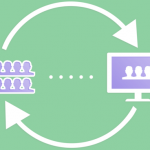Your Brain Has A “Shuffle” Button–Here’s How To Use It
In the early 1890s, everybody wanted the newest technological marvel. Democratic and affordable, the bicycle could cut people’s commute to work in half and enable them to enjoy the countryside on the weekend. Thousands of bicycle mechanics appeared as if overnight, looking to make bicycles lighter, safer, more comfortable, and easier to produce. They would tinker with ball bearings, rolled steel, differential gears, air-filled tires, and so on.
Many of these enthusiasts would later use what they’d learned in bicycle workshops to create greater transportation breakthroughs. Both of the Wright Brothers were bicycle mechanics. So was a man named Henry Ford, who watched mass production take hold at a time when cyclists began lobbying for better roads to be built. Before long, thanks to him, the modern automobile was ambling down them.
The more raw material you give your brain, the more connections it can make. It works a little like hitting “shuffle” on a playlist–the more songs you load it up with, the more surprised you’ll be by the one that comes on next, which may lead you to think differently about both. Perhaps you’ll get an idea for a totally different type of playlist, get inspired to write a song yourself, or even begin to think of music differently as a whole.
The human brain thrives on a wide range of ideas and experiences, especially those it isn’t expecting to encounter. In order to hit upon something really exciting, it first needs to wander, meander, shuffle about. Here’s how to help it.
Sow More Seeds Than You’ll Harvest
When farmers sow seeds, they don’t know which will germinate, which won’t, and how many of those that do germinate will actually bear fruit. It’s nearly impossible to ensure a 100% germination rate. So what do they do? They sow more than they need.
Cognitively speaking, you should, too. Just fill your garden. Or if you prefer the earlier metaphor, add more songs to your playlist than you can possibly listen to in one sitting. That means doing your standard research–to get a handle on the underlying principles, the schools of thought, the ways things have been done or attempted, and succeeded or failed–but it also means looking much further afield, and not knowing what you’ll find.
Read books adjacent to your area of interest. If you’re a scientist, try some science fiction to expand your imagination–or brush up on the history of philosophy, as a way to see the different modes of thought that held people in check. You might discover something about the limits of your own thinking. If you’re a manager, read how the Mongols or the Romans structured their armies, and how they built common cause among soldiers from wildly different cultures.
If you read an article online, follow the links and see where they take you. You may end up down a totally unrelated rabbit-hole, and that’s okay, because you don’t know what might be of interest. You can’t know. This can be frustrating to those of us who prefer working toward a clear goal and hate “wasting time.”
But our brains don’t share that frustration. If you want to lead it toward more breakthrough ideas, you’ve got to let your brain stumble around a little, create uncertainty–and only learn afterward whether it was exactly what you needed, or all for naught.
Related Video: Tapping Into Your Brain’s “Delete” Button
Tapping Others’ Brains For Breakthroughs
Popular mythology would have you believe that breakthroughs are a solo endeavor. But they seldom are. Most often, there are many contributors to major insights.
Talk to people doing the same thing as you are. Bell Labs, the famed research center to which we owe the transistor, the calculator, laser technology, UNIX, and many of today’s most essential technologies, famously encouraged its newest junior members to knock on the door of Nobel Prize winners and ask questions of “the guy who wrote the book.”
You should also talk to people doing something different but related. If you’re a manager in a health-care company, reach out to a manager at a retail company or a hospitality company. If you’re a business manager, learn about how to run a preschool. The garden-filling phase isn’t just about extracting information from other people, though. You also have to share your latest challenges; give people the context behind the questions you’re asking, the problems you’re working on, what’s making them so difficult, and what you’re hoping to achieve.

Whatever you do, keep your mind-set open and unprejudiced; you never know who might have an interesting tidbit for you. Early components of breakthroughs don’t look like breakthroughs–they look like miscellaneous pieces of information. One trick is to keep certain topics at the forefront of your mind at all times so you’ll be more likely to notice when relevant pieces of information pass by.
Another trick is to draw people into talking about something they’re passionate about. Ask them when they first encountered this passion. Did they always love it or did it grow on them? What is it about the activity that speaks to them? You may hear about the history of the thing, the nuances, the best practices. These are excellent ingredients to gather.
Or Just Take A Cue From Einstein
To develop his theories of relativity, Einstein didn’t just lock himself in a room and think. He had a group of friends he talked with almost every night. They called themselves the “Olympia Academy”: Michele Besso, Maurice Solovine, Conrad Habicht, and Einstein’s wife, Mileva.
On warm nights, they’d walk the streets of Bern, in Switzerland, and sit on the riverbank. Other times they’d climb to the top of Mount Gurten, lie on their backs, look up at the stars, and talk until dawn. Then they’d amble back into town and sit at a cafe, fueling themselves with coffee and ideas.
While the Olympia Academy had very little structure, the members demanded total commitment. When Maurice Solovine skipped a meeting to attend a music recital, Einstein and Habicht went to his house, ate all his food, and smoked a pipe (Einstein) and cigars (Habicht) until the apartment resembled the inside of a chimney. Finally, they piled all his furniture and books on top of his bed. Such was the retribution for giving preference to bourgeois distractions over the Academy.
The group’s members were from fields as diverse as poetry and philosophy, and it was these conversations that helped to break open how he thought so that he could then “break open the universe.” In order to be innovative, Einstein first had to shift the way he actually thought–and that meant ranging far afield from physics.
This article is adapted from The Net and the Butterfly: The Art and Practice of Breakthrough Thinking by Olivia Fox Cabane and Judah Pollack, in agreement with Portfolio, an imprint of Penguin Publishing Group, a division of Penguin Random House LLC. Copyright © Olivia Fox Cabane and Judah Pollack, 2017.
Fast Company , Read Full Story
(23)














